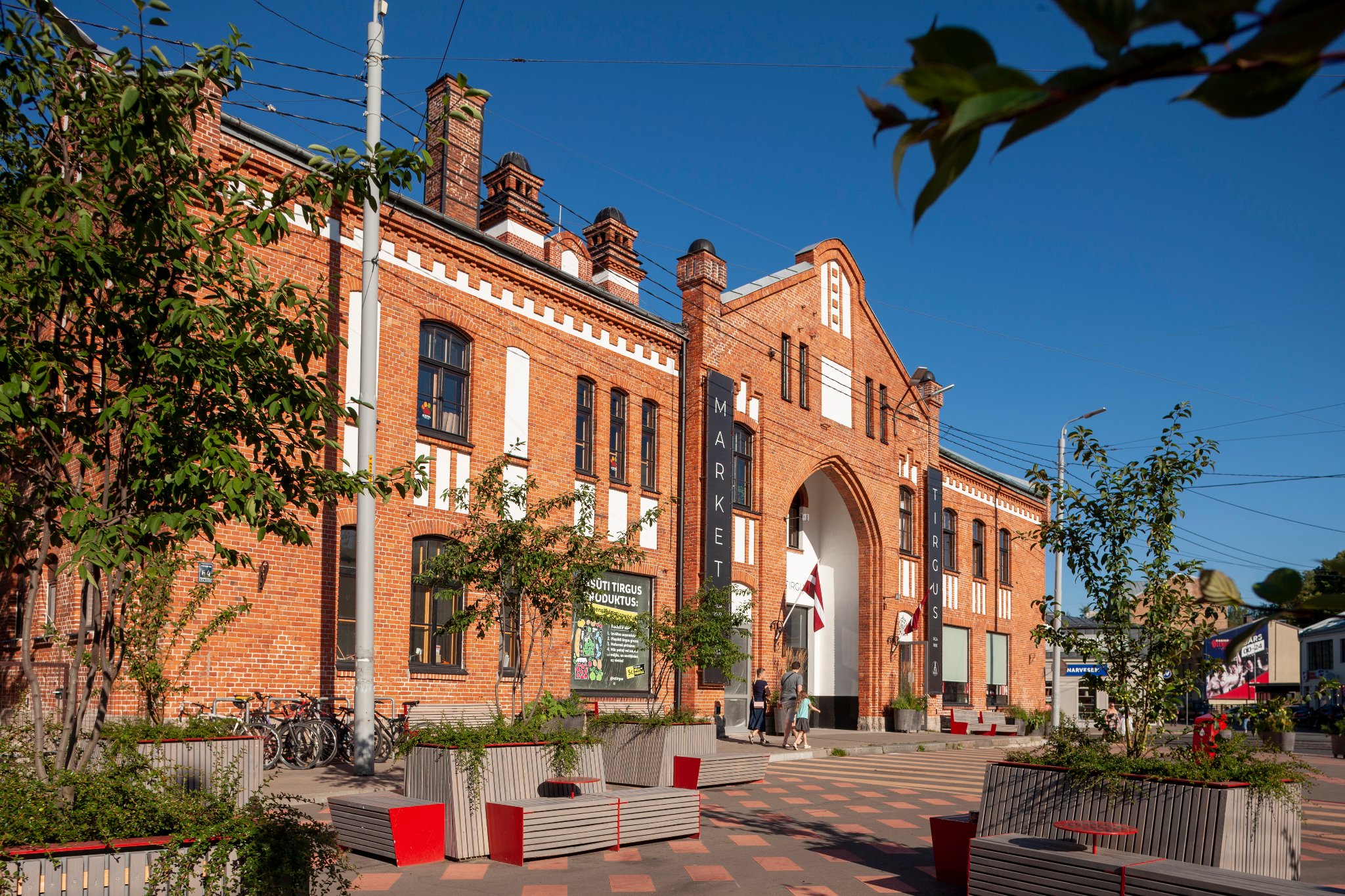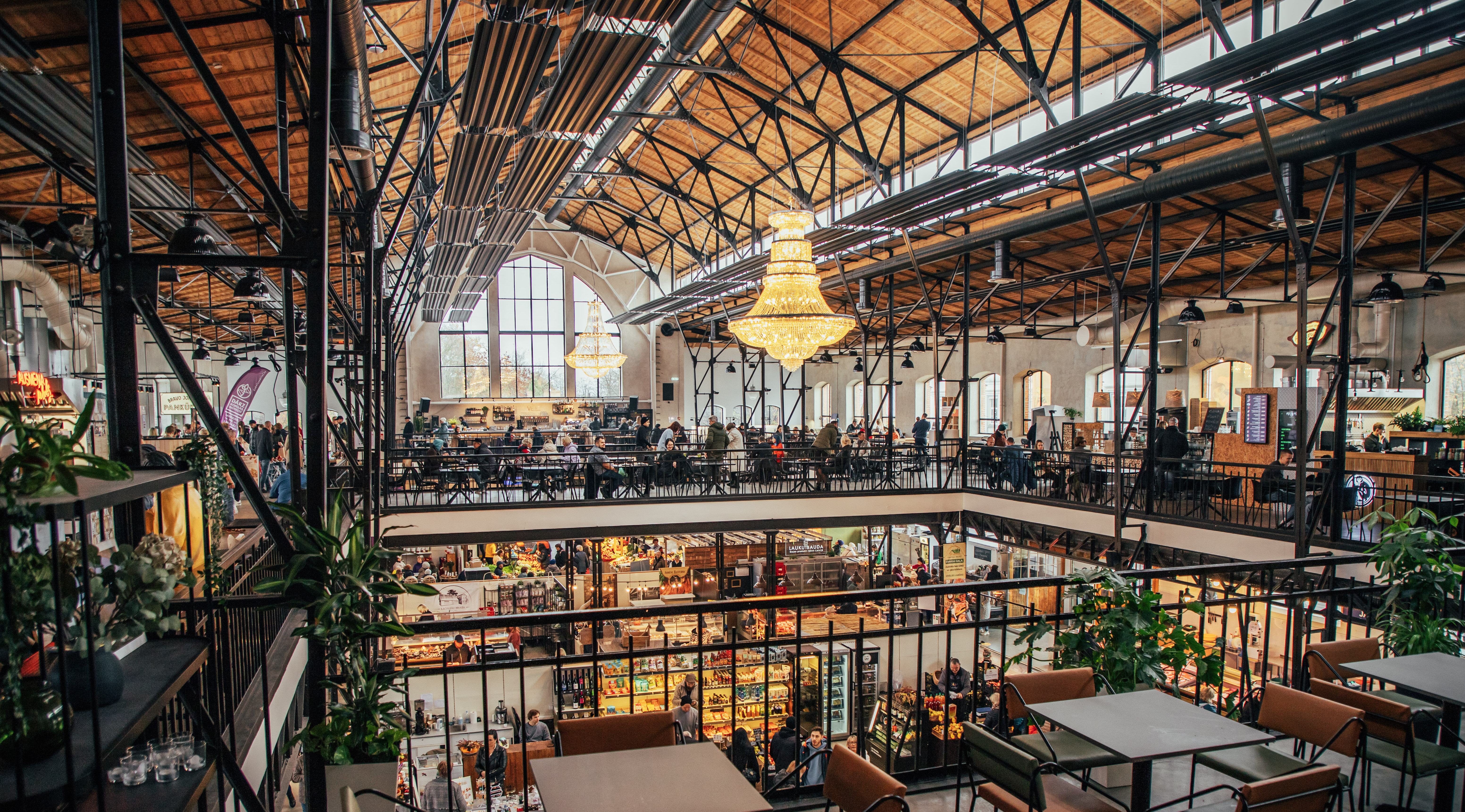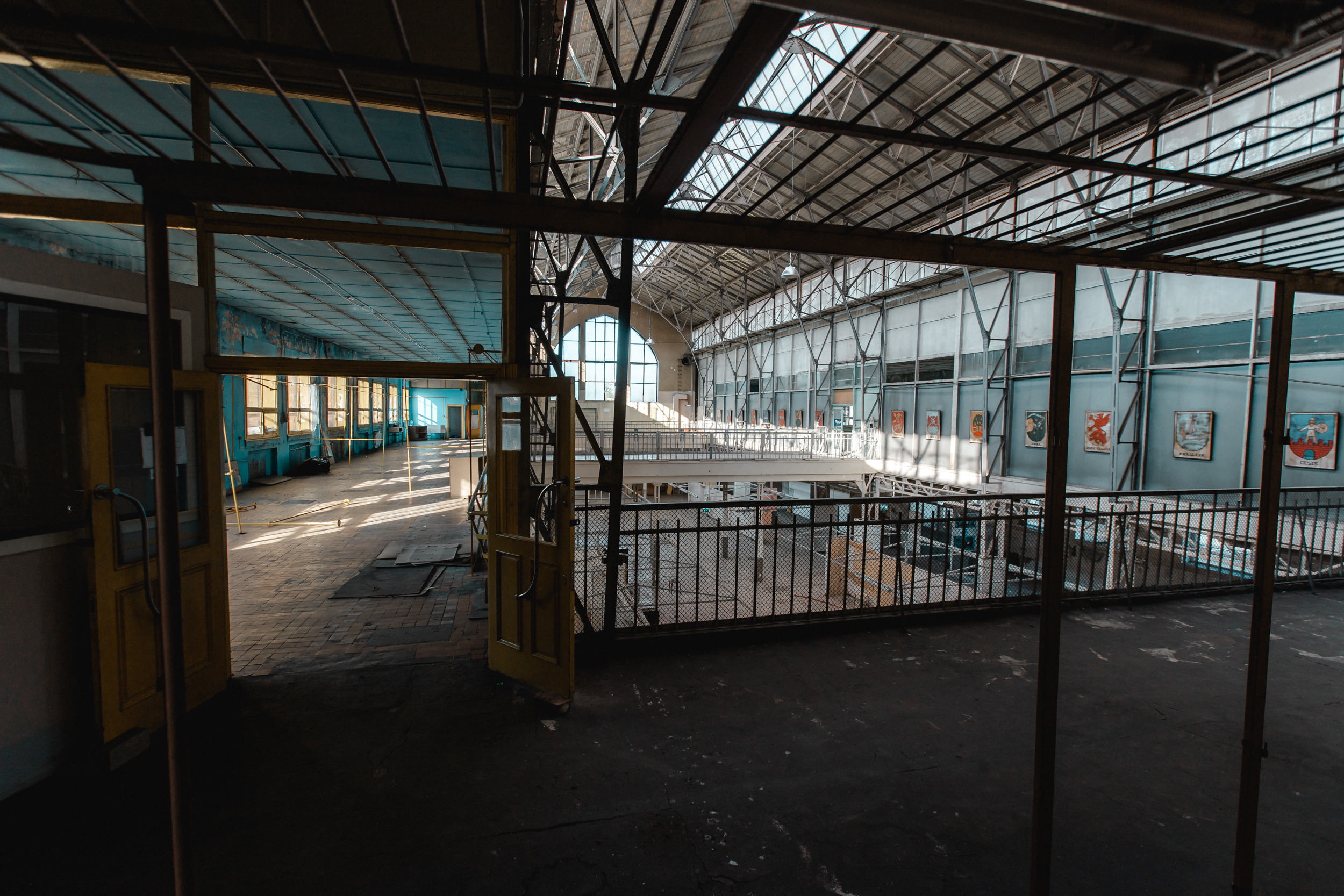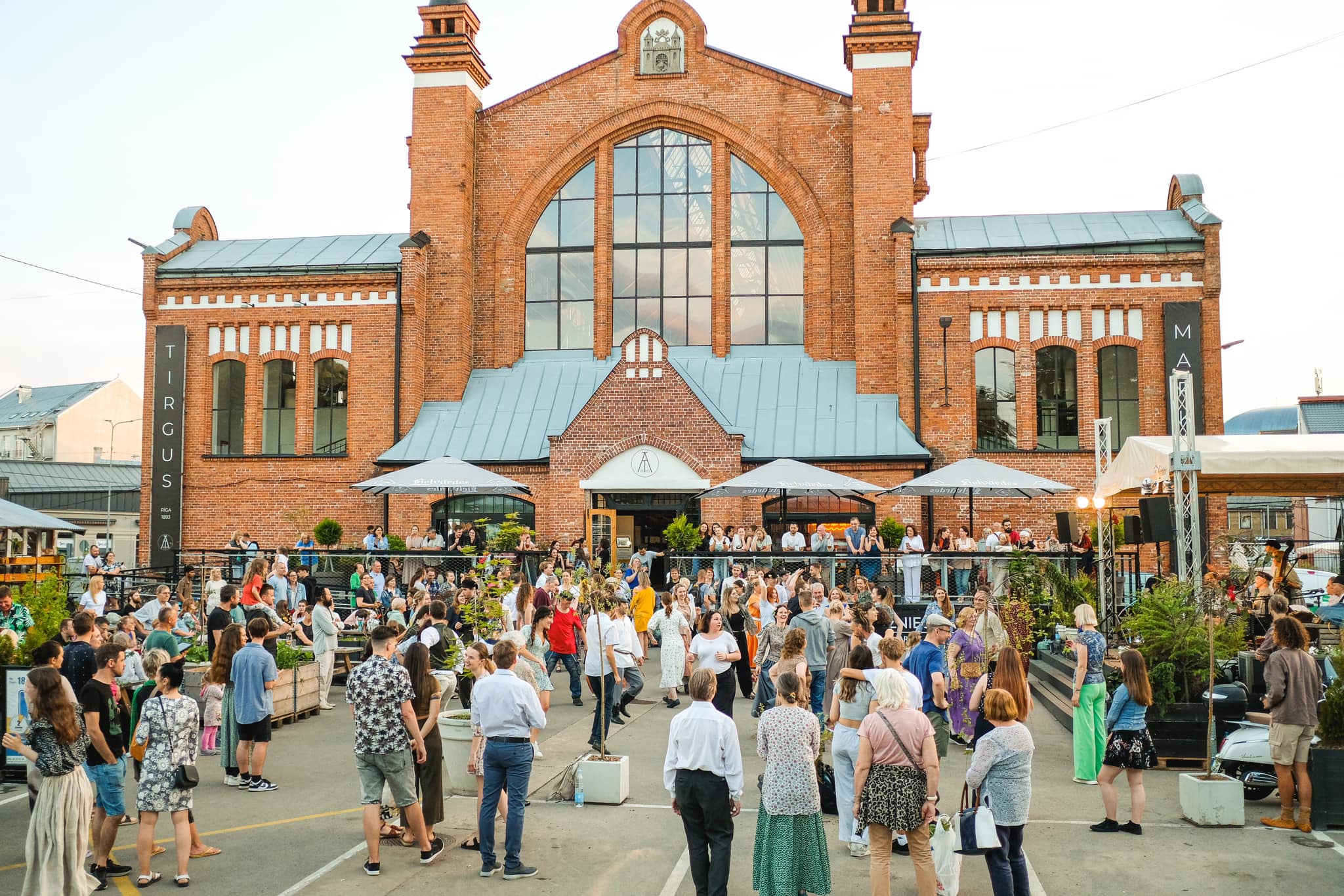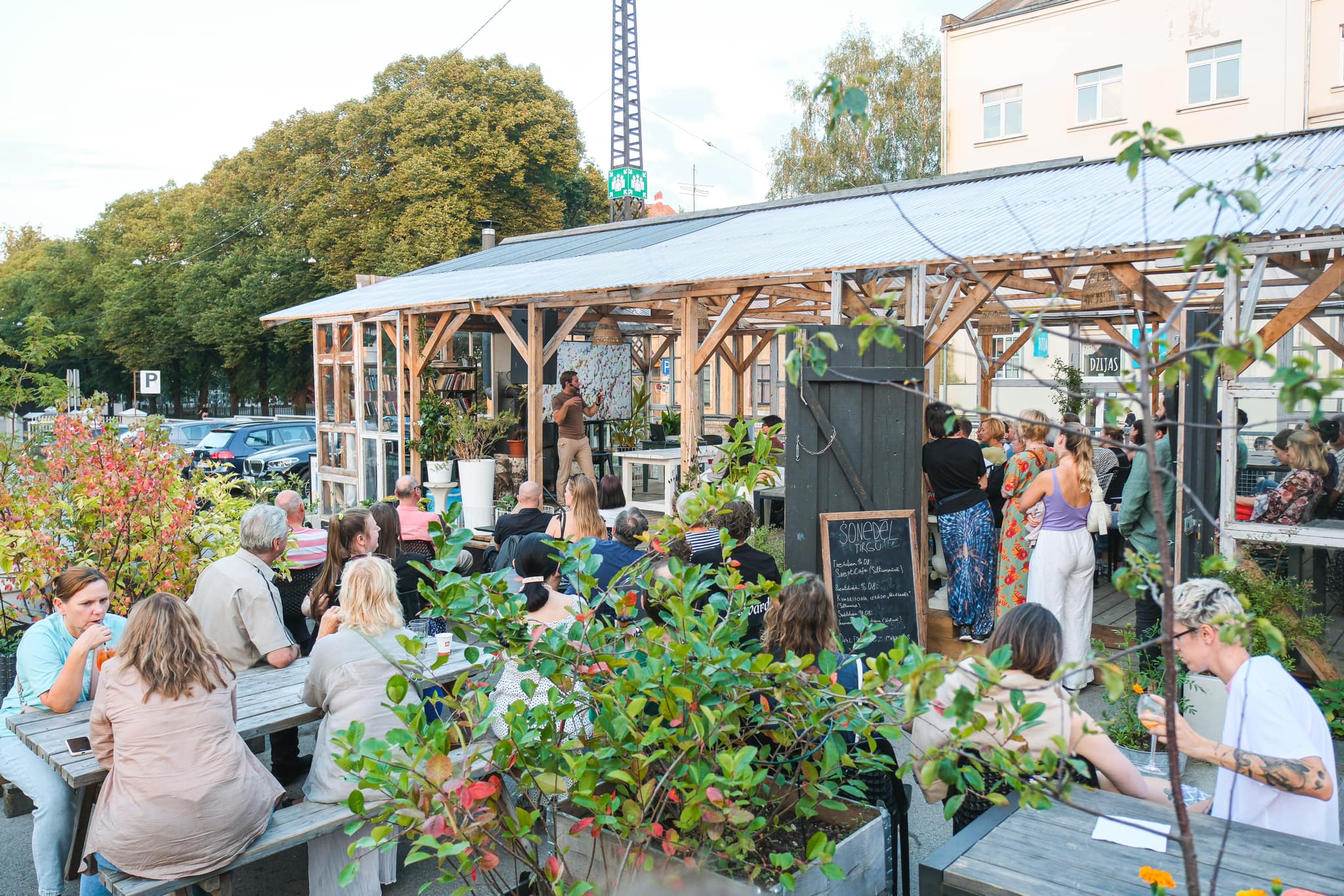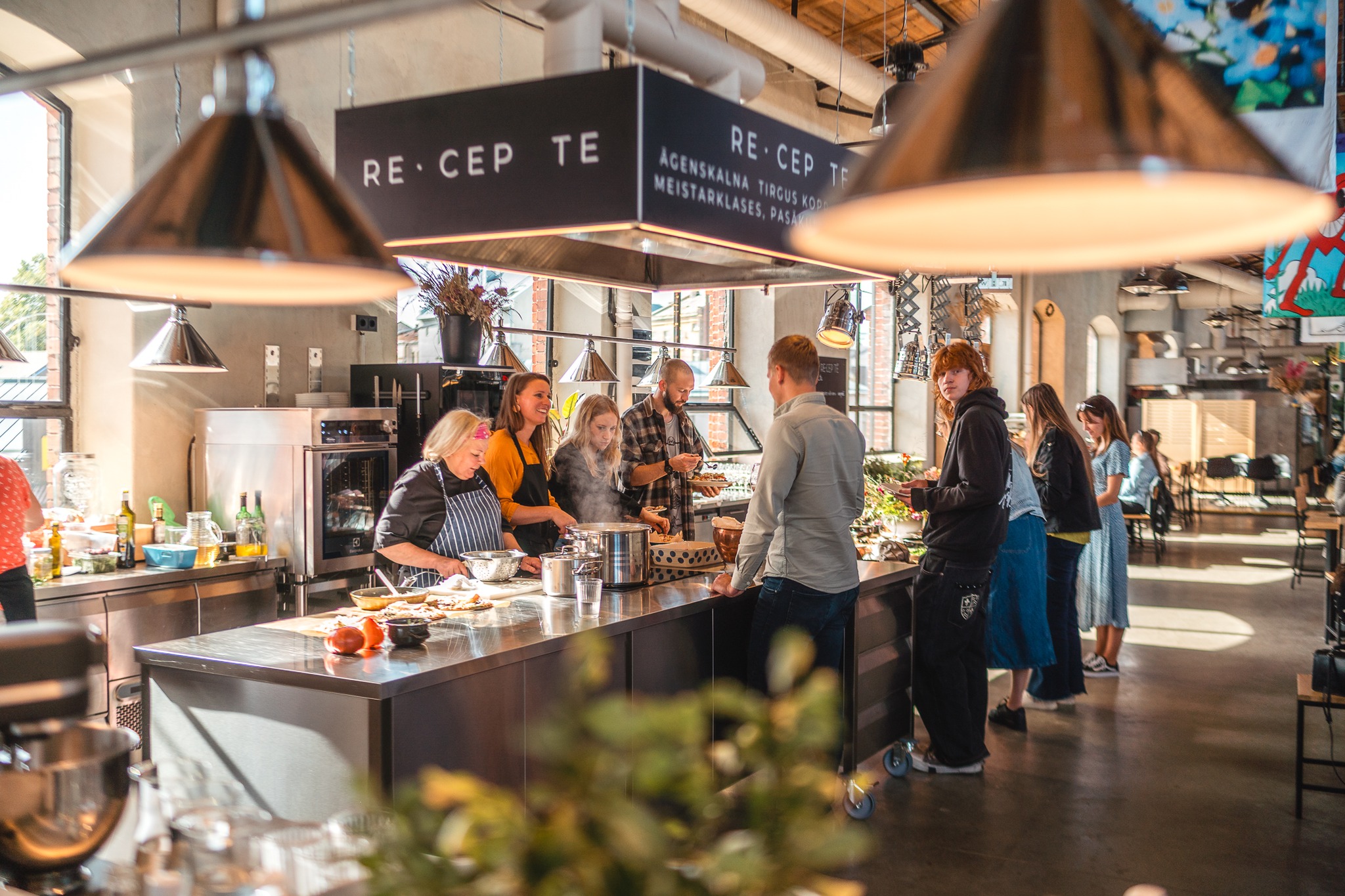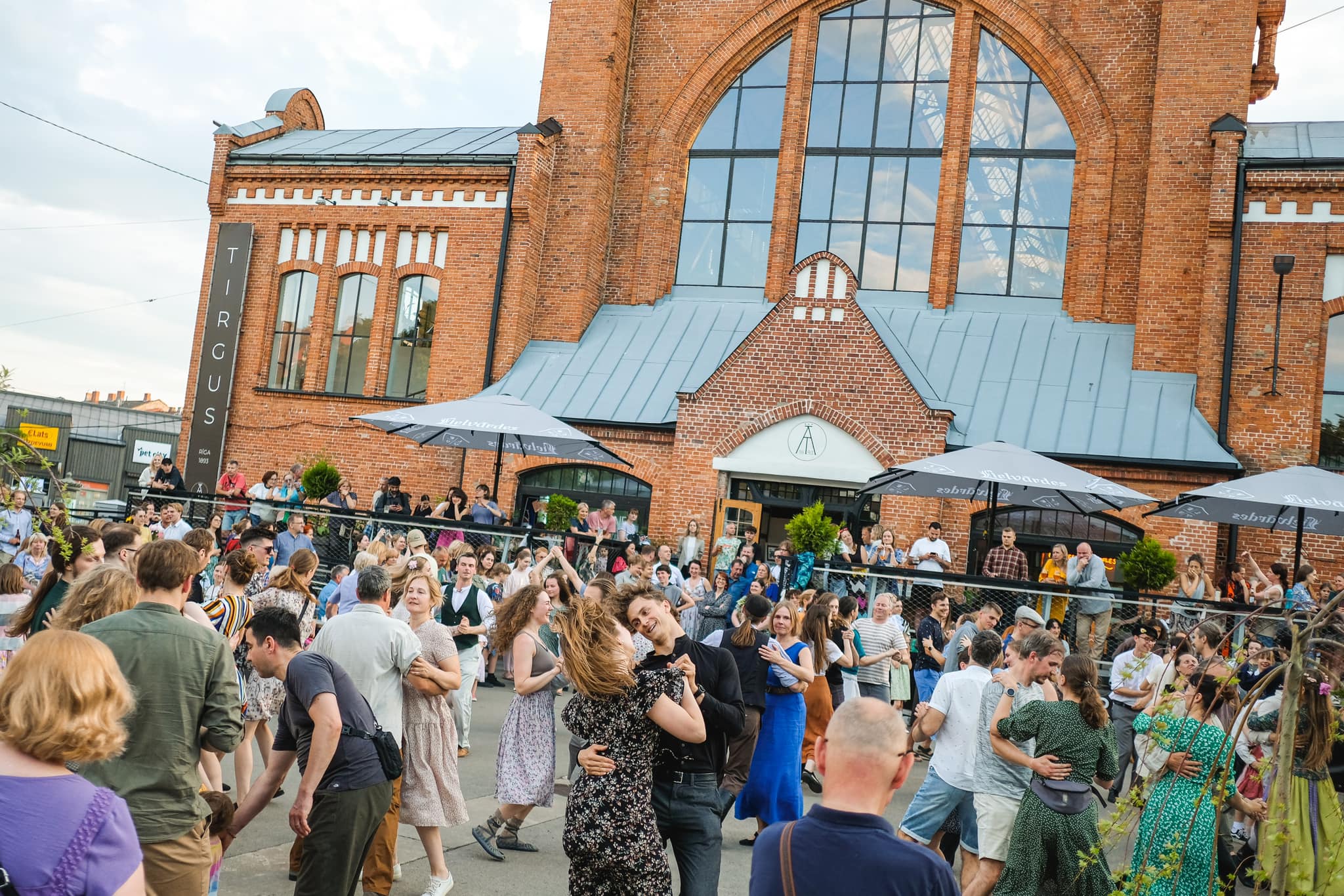Regaining a sense of belonging
Āgenskalns market
Āgenskalns market - citizen market
The revitalization of Āgenskalns market is a citizen-led initiative transformed by a social enterprise into a self-sustaining public marketplace that preserves the cultural heritage and fosters belonging as a community hub. Established in 1898, this municipally owned cultural monument faced closure in 2018 due to deterioration. Recognizing its value, a social enterprise led its revival using participatory methods and private resources, successfully reopening it in 2022.
Latvia
Regional
Riga and Pieriga
It addresses urban-rural linkages
It refers to a physical transformation of the built environment (hard investment)
Yes
2022-05-06
Yes
Horizon2020 / Horizon Europe
No
No
As a representative of an organisation
The revitalization of Āgenskalns market is a compelling example of an initiative that emerged from a civic movement and was transformed by a neighborhood social enterprise into a lively citizen market that preserves cultural heritage while fostering a profound sense of belonging. Established in 1898, this historic market is Riga municipally owned and holds the status of a regional cultural monument. By 2018, the market faced closure due to its deteriorated and dilapidated condition. A team of one of the most vibrant urban spaces in the city (Kalnciema Quarter) responded to the citizen's call with an initiative to revitalize the market through participatory methods and private resources, successfully reopening Āgenskalns market in 2022.
Aim and objectives: by renovating 19th-century market space, celebrating local heritage, contemporary and artistic expressions, the project aims to revitalize the heart of the neighborhood, promote well-being, cultural enrichment and create a stronger community through public space.
Target groups: Āgenskalns market involves a wide array of neighborhood and city residents, striving to be open and inviting to diverse groups. This demographic includes local neighborhood community, families with children, young people, adults of working age, seniors, and various interest and socially vulnerable groups.
Achieved outcomes: a vibrant citizen market, where the community actively participates in revitalizing the space. By preserving historical traditions in a contemporary form, it engages over 1 million participants annually and hosts more than 200 free cultural events a year, it promotes cultural and sustainability awareness while embracing a co-creative approach that fosters community unity and personal agency. The market supports more than 500 local producers and entrepreneurs, currently providing jobs for over 300 individuals, fostering local and slow tourism, and ensuring the long-term continuity of the cultural heritage.
Aim and objectives: by renovating 19th-century market space, celebrating local heritage, contemporary and artistic expressions, the project aims to revitalize the heart of the neighborhood, promote well-being, cultural enrichment and create a stronger community through public space.
Target groups: Āgenskalns market involves a wide array of neighborhood and city residents, striving to be open and inviting to diverse groups. This demographic includes local neighborhood community, families with children, young people, adults of working age, seniors, and various interest and socially vulnerable groups.
Achieved outcomes: a vibrant citizen market, where the community actively participates in revitalizing the space. By preserving historical traditions in a contemporary form, it engages over 1 million participants annually and hosts more than 200 free cultural events a year, it promotes cultural and sustainability awareness while embracing a co-creative approach that fosters community unity and personal agency. The market supports more than 500 local producers and entrepreneurs, currently providing jobs for over 300 individuals, fostering local and slow tourism, and ensuring the long-term continuity of the cultural heritage.
Regeneration of heritage and adaptive reuse: the project focuses on the regeneration of cultural and historical heritage, emphasizing the importance of preserving and practicing local traditions and culture in a contemporary environment.
Cultural revitalization: Āgenskalns market is a hub for celebrating local culture, traditions, contemporary and artistic realities while creating a welcoming environment where community members can participate in practices and decision-making processes.
Integral sustainability: the project implies sustainability throughout its principles and initiatives, emphasizing a comprehensive approach that encompasses environmental, economic, cultural and social dimensions.
Co-creation: it is a fundamental value where diverse members collaboratively shape the Āgenskalns market environment. The project encourages civic engagement and collaborations among people from different social groups.
Well-being: the project aims to enhance the well-being of the community by creating a welcoming and vibrant public space, content and practices.
Āgenskalns market's commitment to sustainability is deeply ingrained in its practice - starting from the decision to take on this challenge of renovating the cultural heritage to tangible actions:
- Preservation and circular economy: the project team aimed to preserve historical details and repurpose existing materials that embody the value and story of the space, and only disposed elements that completely degraded the environment. The team actively engaged in the reuse and restoration, for instance, building components from the old market and other spaces (windows, doors, forges, constructions, etc.), and the world of objects (work tables, scales, chandeliers, coats of arms, boxes for community garden, greenhouse, etc.); the team discovered a historic ice storage and uncovered a portion of the historic pavement beneath the asphalt that the municipality and community did not know existed before.
- Promotion of sustainable initiatives: these include a first-hand food purchase, free-packaging point for reducing waste, book exchange, and plant-exchange points that encourage resource sharing and waste reduction. The project hosts over 80 free events annually specifically aimed at educating on sustainable practices from reducing food waste to repairing and repurposing items.
- Participatory practices: the engagement of the local community in decision-making and the co-creation of the environment is a testament to sustainability. Recent research by local sociologists confirmed that participation in market life enhances local people’s agency, fostering a sense of ownership and shared responsibility. This involvement encourages residents to actively shape their environment.
- Ongoing development: the market is a long-term initiative with a 30-year lease agreement with the municipality, ensuring its sustainability. Continuous improvements are made to adapt to community needs and interests, reinforcing its role as a dynamic, evolving public space.
- Preservation and circular economy: the project team aimed to preserve historical details and repurpose existing materials that embody the value and story of the space, and only disposed elements that completely degraded the environment. The team actively engaged in the reuse and restoration, for instance, building components from the old market and other spaces (windows, doors, forges, constructions, etc.), and the world of objects (work tables, scales, chandeliers, coats of arms, boxes for community garden, greenhouse, etc.); the team discovered a historic ice storage and uncovered a portion of the historic pavement beneath the asphalt that the municipality and community did not know existed before.
- Promotion of sustainable initiatives: these include a first-hand food purchase, free-packaging point for reducing waste, book exchange, and plant-exchange points that encourage resource sharing and waste reduction. The project hosts over 80 free events annually specifically aimed at educating on sustainable practices from reducing food waste to repairing and repurposing items.
- Participatory practices: the engagement of the local community in decision-making and the co-creation of the environment is a testament to sustainability. Recent research by local sociologists confirmed that participation in market life enhances local people’s agency, fostering a sense of ownership and shared responsibility. This involvement encourages residents to actively shape their environment.
- Ongoing development: the market is a long-term initiative with a 30-year lease agreement with the municipality, ensuring its sustainability. Continuous improvements are made to adapt to community needs and interests, reinforcing its role as a dynamic, evolving public space.
- Conservation of traditions: the project maintains the architectural and cultural elements that define the market's character and charm. The careful preservation of these traditions ensures a deep connection with the neighborhood's past and fosters a sense of common identity and continuity.
- Creating versatile spaces: the transformation of the market space is purposely designed to enhance people's well-being - the spaces were repurposed to cater to various needs, whether for socializing with friends and family in the historical pavilion, a quiet corner in the greenhouse for solitary activities, or cultural practices with neighbors in the courtyard and community garden. These diverse spaces ensure that everyone can find their place of belonging within the market. Unlike static commercial areas, the market is a living, evolving environment where people actively shape and inhabit the space daily. A unique aspect of the project is the provision of a large, inclusive gathering space under the roof throughout the year, previously lacking in Riga and representing a departure from the Soviet past when such spaces were degraded.
- Promoting cultural and social revitalization: physical transformation and co-created cultural activities have breathed new life into the space, making it a more inviting and vibrant space where people want to gather, stay, and return. These initiatives have revitalized the cultural and social life of the community, transforming the market into a hub of exchange, learning, and collaboration through workshops, concerts, community theater, exhibitions, readings, guided tours, thematic markets, etc. cultural activities.
- Adapting to contemporary dynamics: the aim was to create a flexible and adaptable environment that aligns with the essence and relevance of the market in real-time. The deliberate design and large open space allow the market to evolve with changing needs and embody the market's commitment to serving the community.
- Creating versatile spaces: the transformation of the market space is purposely designed to enhance people's well-being - the spaces were repurposed to cater to various needs, whether for socializing with friends and family in the historical pavilion, a quiet corner in the greenhouse for solitary activities, or cultural practices with neighbors in the courtyard and community garden. These diverse spaces ensure that everyone can find their place of belonging within the market. Unlike static commercial areas, the market is a living, evolving environment where people actively shape and inhabit the space daily. A unique aspect of the project is the provision of a large, inclusive gathering space under the roof throughout the year, previously lacking in Riga and representing a departure from the Soviet past when such spaces were degraded.
- Promoting cultural and social revitalization: physical transformation and co-created cultural activities have breathed new life into the space, making it a more inviting and vibrant space where people want to gather, stay, and return. These initiatives have revitalized the cultural and social life of the community, transforming the market into a hub of exchange, learning, and collaboration through workshops, concerts, community theater, exhibitions, readings, guided tours, thematic markets, etc. cultural activities.
- Adapting to contemporary dynamics: the aim was to create a flexible and adaptable environment that aligns with the essence and relevance of the market in real-time. The deliberate design and large open space allow the market to evolve with changing needs and embody the market's commitment to serving the community.
- This project is designed to be inclusive and accessible to all members of the community. This is achieved through physical adaptations, such as ramps, elevator and improved infrastructure that has never existed before at the market, to ensure that people can easily navigate the space. It also cooperates with organization that advocate for people with disabilities to enhance the inclusivity of the environment and cater to diverse needs.
- Āgenskalns market is open to the public without entry fees throughout the whole year. The project aims to provide affordable and diverse products and services. This affordability also extends to free cultural programs - more than 200 co-created events held throughout the year for various interests. An important aspect is that people are welcome to spend time at the market without the need to buy anything.
- The project has emerged as a civic movement and from that on actively involves the local community in the revitalization process. From the initial stages of conceptualization to the ongoing development of the market, residents and stakeholders contribute, adapt, and enhance the environment and its social and cultural life. This inclusive approach ensures that the market serves the community's interests and reflects its values.
- By understanding the spirit of the neighborhood and its people, the project team has considered the needs and experiences of diverse social groups. This includes making the physical space accessible to people of all ages and abilities and fostering an environment where people from different backgrounds and interests can come together, and at the same time have individual experience at the market. The team with local journalists and artists gathered people's stories and memories about the market - based on that created printed editions, self-guided tours, and developed a children's interactive game to discover the space, ensuring different experiences and belonging to the market.
- Āgenskalns market is open to the public without entry fees throughout the whole year. The project aims to provide affordable and diverse products and services. This affordability also extends to free cultural programs - more than 200 co-created events held throughout the year for various interests. An important aspect is that people are welcome to spend time at the market without the need to buy anything.
- The project has emerged as a civic movement and from that on actively involves the local community in the revitalization process. From the initial stages of conceptualization to the ongoing development of the market, residents and stakeholders contribute, adapt, and enhance the environment and its social and cultural life. This inclusive approach ensures that the market serves the community's interests and reflects its values.
- By understanding the spirit of the neighborhood and its people, the project team has considered the needs and experiences of diverse social groups. This includes making the physical space accessible to people of all ages and abilities and fostering an environment where people from different backgrounds and interests can come together, and at the same time have individual experience at the market. The team with local journalists and artists gathered people's stories and memories about the market - based on that created printed editions, self-guided tours, and developed a children's interactive game to discover the space, ensuring different experiences and belonging to the market.
- The revitalization of the market originated from the active demand of local residents, who recognized the need to preserve and restore the space and urged the municipality to address the market’s future after closure. This strong public interest sparked a citizen involvement that drove the initiative, ultimately leading our social enterprise (also from this neighborhood) to take the lead in transforming the market.
- From the very beginning, citizens have been deeply involved in shaping its future, contributing ideas, participating in cultural and physical improvements, and ensuring that the market reflects their needs. This process not only demonstrates the importance of the space for the community but also proves that people both need and benefit from an accessible, evolving, and socially driven public marketplace.
- The project embraced a co-creative approach, involving citizens in shaping various spaces within the market. This includes the co-creation kitchen, courtyard, community garden, and cultural program. Citizens engage in suggesting solutions, providing feedback, and collaborating with the project team to shape these spaces according to their needs and aspirations. For instance, citizens were involved in a municipality-announced project competition for neighborhood ideas, resulting in the transformation of the front yard of Āgenskalns market. This collaborative decision-making process empowers citizens to contribute to shaping the public spaces they use. This involvement ensures that the project is not only responsive to community needs but also reflective of the diverse interests within the neighborhood.
- By actively inviting citizens into revitalization efforts, the team creates a stronger connection and a sense of ownership among citizens to Āgenskalns market and invites to view it as community space, leading to increased sense of belonging. This has contributed to the market becoming a vibrant and thriving community hub.
- From the very beginning, citizens have been deeply involved in shaping its future, contributing ideas, participating in cultural and physical improvements, and ensuring that the market reflects their needs. This process not only demonstrates the importance of the space for the community but also proves that people both need and benefit from an accessible, evolving, and socially driven public marketplace.
- The project embraced a co-creative approach, involving citizens in shaping various spaces within the market. This includes the co-creation kitchen, courtyard, community garden, and cultural program. Citizens engage in suggesting solutions, providing feedback, and collaborating with the project team to shape these spaces according to their needs and aspirations. For instance, citizens were involved in a municipality-announced project competition for neighborhood ideas, resulting in the transformation of the front yard of Āgenskalns market. This collaborative decision-making process empowers citizens to contribute to shaping the public spaces they use. This involvement ensures that the project is not only responsive to community needs but also reflective of the diverse interests within the neighborhood.
- By actively inviting citizens into revitalization efforts, the team creates a stronger connection and a sense of ownership among citizens to Āgenskalns market and invites to view it as community space, leading to increased sense of belonging. This has contributed to the market becoming a vibrant and thriving community hub.
Local:
- Ltd. Kalnciema iela - social enterprise leading the revitalization of the market with a governing model of participatory and sustainable practices.
- Riga municipality owns the building and courtyard, gives permissions and ensures the employment of agreement.
- Āgenskalns residents and neighbourhood association. The market revitalization project acted as a catalyst to the establishment of the association. Regular community meetings, surveys, and discussions with association and residents ensure a participatory approach.
- A network of more than 500 producers contributes to the market's vitality, ensuring a diverse range of products and fostering a dynamic and thriving market space.
- Local cultural, social, and environmental organizations - market serves as a free platform to support local initiatives that represent various interests and engage people.
- Collaboration with Apeirons and Sustento improved accessibility for people with disabilities.
- Partnerships with Zero Waste Latvija and Zaļā brīvība focuses on waste reduction initiatives.
- Collaborating with universities (Riga Technical University, Stradins University, Riseba, Turība) involves students in the revitalization process and provides them with valuable real-world experience, from architecture projects to multimedia contributions.
- Collaboration with organizations like Young Folks encourages youth initiatives, particularly involving Russian-speaking youth.
Regional: Baltic Studies Center and Riga Planning Region brings sociological and regional planning perspectives.
National: State Inspection for Heritage Protection coordinates all aspects related to the building and its historical preservation.
Global:
- The engagement of international partners (Reading University, Cordoba University, TESSERAE, etc.), including urban planning, social sciences, architecture, and arts, brings diverse expertise to the project.
- Participation in the International Public Markets Conference.
- Ltd. Kalnciema iela - social enterprise leading the revitalization of the market with a governing model of participatory and sustainable practices.
- Riga municipality owns the building and courtyard, gives permissions and ensures the employment of agreement.
- Āgenskalns residents and neighbourhood association. The market revitalization project acted as a catalyst to the establishment of the association. Regular community meetings, surveys, and discussions with association and residents ensure a participatory approach.
- A network of more than 500 producers contributes to the market's vitality, ensuring a diverse range of products and fostering a dynamic and thriving market space.
- Local cultural, social, and environmental organizations - market serves as a free platform to support local initiatives that represent various interests and engage people.
- Collaboration with Apeirons and Sustento improved accessibility for people with disabilities.
- Partnerships with Zero Waste Latvija and Zaļā brīvība focuses on waste reduction initiatives.
- Collaborating with universities (Riga Technical University, Stradins University, Riseba, Turība) involves students in the revitalization process and provides them with valuable real-world experience, from architecture projects to multimedia contributions.
- Collaboration with organizations like Young Folks encourages youth initiatives, particularly involving Russian-speaking youth.
Regional: Baltic Studies Center and Riga Planning Region brings sociological and regional planning perspectives.
National: State Inspection for Heritage Protection coordinates all aspects related to the building and its historical preservation.
Global:
- The engagement of international partners (Reading University, Cordoba University, TESSERAE, etc.), including urban planning, social sciences, architecture, and arts, brings diverse expertise to the project.
- Participation in the International Public Markets Conference.
The market, being a complex and intertwined organism within the community, necessitated a comprehensive understanding of its multifaceted nature for successful revitalization.
- Architecture and cultural heritage preservation: experts from these fields ensured the restoration and adaptive reuse of historical features, contributing to the market's identity.
- Contemporary arts and culture: collaboration with local artists and organizations enriched the project with a dynamic cultural life that celebrates local and national cultural expressions and reflects contemporary realities.
- Sustainability and environmental fields: involved experts in sustainability, waste reduction and ecological design and practices contributed to a market that aligns with contemporary environmental consciousness.
- Social sciences and community engagement: a comprehensive understanding of regeneration went beyond physical structures by involvement of community members, local cultural and social organizations, volunteers and various interest groups in collaboration with social scientists. The project team organized gatherings and focus groups, conducted surveys, and engaged in regular discussions to ensure the project resonated with the needs and desires of the community.
- Urban planning: expertise to optimize the layout of the market space involved considerations for accessibility, community engagement, and the incorporation of green spaces, enhancing the overall urban experience.
- Food supply chain management: working with food producers and experts contributed to improving the logistics, processes, and systems involved in the production, distribution, and consumption of food products.
- Social entrepreneurship: this approach of the project's team ensures that long-term economic aspects are balanced with a commitment to community well-being.
- Architecture and cultural heritage preservation: experts from these fields ensured the restoration and adaptive reuse of historical features, contributing to the market's identity.
- Contemporary arts and culture: collaboration with local artists and organizations enriched the project with a dynamic cultural life that celebrates local and national cultural expressions and reflects contemporary realities.
- Sustainability and environmental fields: involved experts in sustainability, waste reduction and ecological design and practices contributed to a market that aligns with contemporary environmental consciousness.
- Social sciences and community engagement: a comprehensive understanding of regeneration went beyond physical structures by involvement of community members, local cultural and social organizations, volunteers and various interest groups in collaboration with social scientists. The project team organized gatherings and focus groups, conducted surveys, and engaged in regular discussions to ensure the project resonated with the needs and desires of the community.
- Urban planning: expertise to optimize the layout of the market space involved considerations for accessibility, community engagement, and the incorporation of green spaces, enhancing the overall urban experience.
- Food supply chain management: working with food producers and experts contributed to improving the logistics, processes, and systems involved in the production, distribution, and consumption of food products.
- Social entrepreneurship: this approach of the project's team ensures that long-term economic aspects are balanced with a commitment to community well-being.
An initiative platform. This project extends beyond traditional market functions to serve as a dynamic social hub. Market not only stands as a contemporary art space but surpasses this designation by incorporating diverse social functions and actively supporting a spectrum of initiatives that extend to health, environment, local heritage, aid for socially vulnerable groups, etc. At the heart of the market’s innovation is its participatory model, where citizens play an active role in shaping the space daily. Recent research by local sociologists shows that community involvement has not only improved civic engagement but also contributed to a heightened people’s sense of agency, belonging to the neighborhood, and their well-being.
Āgenskalns market successfully combines the preservation of its rich cultural heritage with contemporary reality. It identifies and responds to community needs, including enhancing environmental accessibility throughout its territory. It has introduced green spaces that were previously absent, improving the quality of life and contributing to the creation of new urban public space.
Sustainable local food circulation: Āgenskalns market prioritizes the development of sustainable local food supply chains, ensuring that locally sourced products are first-hand readily available to the community. Additionally, it has introduced diverse food distribution practices, for instance, 24/7 food pick-up point, a food circulation center, it actively engages in activities aimed at reducing food waste, such as cooking in the co-creation kitchen and offering last-day lower prices, further promoting sustainability.
Pioneering public-private partnership. This pioneering example of a public-private partnership sets a valuable precedent of its kind in the region. Although for the project team it has not been an easy process, it can serve as an inspiration and catalyst for future collaborations in this region, enabling similar projects to move forward.
Āgenskalns market successfully combines the preservation of its rich cultural heritage with contemporary reality. It identifies and responds to community needs, including enhancing environmental accessibility throughout its territory. It has introduced green spaces that were previously absent, improving the quality of life and contributing to the creation of new urban public space.
Sustainable local food circulation: Āgenskalns market prioritizes the development of sustainable local food supply chains, ensuring that locally sourced products are first-hand readily available to the community. Additionally, it has introduced diverse food distribution practices, for instance, 24/7 food pick-up point, a food circulation center, it actively engages in activities aimed at reducing food waste, such as cooking in the co-creation kitchen and offering last-day lower prices, further promoting sustainability.
Pioneering public-private partnership. This pioneering example of a public-private partnership sets a valuable precedent of its kind in the region. Although for the project team it has not been an easy process, it can serve as an inspiration and catalyst for future collaborations in this region, enabling similar projects to move forward.
Key steps in the methodology include:
1. The project prioritized collaboration with the local community from the outset in 2018 - a public questionnaire about the market's future concept and vision gathered responses from 1700 individuals within a week. Public discussions and focus groups with Āgenskalns residents and the establishment of a neighborhood association further deepened community engagement.
2. The collaborative effort resulted in the formulation of a comprehensive vision for the market's revitalization. This vision played a crucial role in the subsequent stages of the project, balancing historical preservation, contemporary needs, and participatory engagement.
3. The proposed vision and commitment secured success in the public auction, granting the lease right for the Āgenskalns market for the next 30 years, serving as first such example of public-private partnership in Latvia.
4. To ensure continuous market operations and preserve access to local food and work possibilities for producers, the team decided to restore market activities the same year in the courtyard while the historical pavilion underwent renovation. This allowed for ongoing market functions and the development of new initiatives.
5. Throughout the project, the team actively collaborated with stakeholders, including the municipality, neighborhood association, volunteers, cultural, social, environmental organizations, scientists and producers. These collaborations facilitated knowledge exchange, funding opportunities, and policy dialogue, ensuring the market’s long-term adaptability and public value.
6. The phased approach continued with the opening of the historical pavilion in 2022. Since reopening, the team has continued to enhance infrastructure, expand cultural programming involving local citizens, and integrate new sustainability initiatives based on ongoing community feedback.
7. Now the multidisciplinary approach has positioned Āgenskalns market as a model for other cities.
1. The project prioritized collaboration with the local community from the outset in 2018 - a public questionnaire about the market's future concept and vision gathered responses from 1700 individuals within a week. Public discussions and focus groups with Āgenskalns residents and the establishment of a neighborhood association further deepened community engagement.
2. The collaborative effort resulted in the formulation of a comprehensive vision for the market's revitalization. This vision played a crucial role in the subsequent stages of the project, balancing historical preservation, contemporary needs, and participatory engagement.
3. The proposed vision and commitment secured success in the public auction, granting the lease right for the Āgenskalns market for the next 30 years, serving as first such example of public-private partnership in Latvia.
4. To ensure continuous market operations and preserve access to local food and work possibilities for producers, the team decided to restore market activities the same year in the courtyard while the historical pavilion underwent renovation. This allowed for ongoing market functions and the development of new initiatives.
5. Throughout the project, the team actively collaborated with stakeholders, including the municipality, neighborhood association, volunteers, cultural, social, environmental organizations, scientists and producers. These collaborations facilitated knowledge exchange, funding opportunities, and policy dialogue, ensuring the market’s long-term adaptability and public value.
6. The phased approach continued with the opening of the historical pavilion in 2022. Since reopening, the team has continued to enhance infrastructure, expand cultural programming involving local citizens, and integrate new sustainability initiatives based on ongoing community feedback.
7. Now the multidisciplinary approach has positioned Āgenskalns market as a model for other cities.
Several elements of the Āgenskalns market project have the potential to be replicated or transferred:
1. Sustaining collaboration and trusting community network: the collaborative network and the culture of trust and cooperation cultivated at Āgenskalns market. Building strong connections with over 1000 active stakeholders, from producers to community members and organizations, is a successful practice that can be emulated. This collaborative approach has proven essential for creating a solid foundation for ongoing operations and long-term sustainability. The experience of fostering community engagement and trust can be shared and applied in other community-driven projects.
2. Public-private partnerships: Āgenskalns market serves as an exemplary case of public-private partnership, demonstrating how a social enterprise can collaborate with local governments. The unique nature of this partnership, where the responsibility for municipality-owned historical heritage completely falls on the social enterprise, offers an alternative model for achieving community development objectives. This example could inspire similar partnerships in other regions, enabling more efficient and community-driven initiatives.
3. Preservation and development of local markets and urban spaces: the global importance of preserving and revitalizing local markets and historical spaces within urban contexts is a significant outtake from Āgenskalns market. Markets play a crucial role in urban ecosystems as multifunctional public spaces. The success of the Āgenskalns market project in redefining urban space culture offers insights and best practices for maintaining and enhancing markets and historical spaces worldwide.
4. Āgenskalns market can contribute with the strategic and long-term vision to the development of vibrant, inclusive, and sustainable community spaces, inspiring other initiatives toward cultural revitalization, preservation, and community inclusion.
1. Sustaining collaboration and trusting community network: the collaborative network and the culture of trust and cooperation cultivated at Āgenskalns market. Building strong connections with over 1000 active stakeholders, from producers to community members and organizations, is a successful practice that can be emulated. This collaborative approach has proven essential for creating a solid foundation for ongoing operations and long-term sustainability. The experience of fostering community engagement and trust can be shared and applied in other community-driven projects.
2. Public-private partnerships: Āgenskalns market serves as an exemplary case of public-private partnership, demonstrating how a social enterprise can collaborate with local governments. The unique nature of this partnership, where the responsibility for municipality-owned historical heritage completely falls on the social enterprise, offers an alternative model for achieving community development objectives. This example could inspire similar partnerships in other regions, enabling more efficient and community-driven initiatives.
3. Preservation and development of local markets and urban spaces: the global importance of preserving and revitalizing local markets and historical spaces within urban contexts is a significant outtake from Āgenskalns market. Markets play a crucial role in urban ecosystems as multifunctional public spaces. The success of the Āgenskalns market project in redefining urban space culture offers insights and best practices for maintaining and enhancing markets and historical spaces worldwide.
4. Āgenskalns market can contribute with the strategic and long-term vision to the development of vibrant, inclusive, and sustainable community spaces, inspiring other initiatives toward cultural revitalization, preservation, and community inclusion.
1. Inclusivity and collaboration across social groups: Āgenskalns market acts as a platform for the inclusion and collaboration of diverse social groups. It facilitates the exchange of experiences, addresses the needs of various societal segments. By creating a space for social interaction and engagement, the project contributes to the global objective of fostering inclusivity and addressing issues faced by various segments of society.
2. Promoting health and well-being through public space: by creating an attractive and vibrant public space, the project enhances the quality of life for the local community. Public spaces play a significant role in the physical and mental well-being of residents, and the project's focus on revitalization demonstrates how local initiatives can positively impact the health and well-being of a community.
3. Preserving markets worldwide: Āgenskalna market example showcases how to maintain and nurture market cultural significance within a city's ecosystem. And it does so in an innovative and multidisciplinary manner. By revitalizing and preserving this market locally with open pathways and collaborations internationally, the project contributes to the global challenge of sustaining traditional markets, which are not only places of commerce but also significant cultural landmarks in urban settings and are integral to a city's identity.
4. Ensuring food availability and community links: the project at Āgenskalns market focuses on ensuring food availability, successful food supply chains, and fostering community connections through the promotion of local culinary heritage. This is vital not only in the Latvian context but also globally as food serves as a link between people, and the project acknowledges its role in connecting communities. Additionally, it addresses various related areas, including environmental sustainability, health, and well-being, as a part of creating a more sustainable and interconnected food system.
2. Promoting health and well-being through public space: by creating an attractive and vibrant public space, the project enhances the quality of life for the local community. Public spaces play a significant role in the physical and mental well-being of residents, and the project's focus on revitalization demonstrates how local initiatives can positively impact the health and well-being of a community.
3. Preserving markets worldwide: Āgenskalna market example showcases how to maintain and nurture market cultural significance within a city's ecosystem. And it does so in an innovative and multidisciplinary manner. By revitalizing and preserving this market locally with open pathways and collaborations internationally, the project contributes to the global challenge of sustaining traditional markets, which are not only places of commerce but also significant cultural landmarks in urban settings and are integral to a city's identity.
4. Ensuring food availability and community links: the project at Āgenskalns market focuses on ensuring food availability, successful food supply chains, and fostering community connections through the promotion of local culinary heritage. This is vital not only in the Latvian context but also globally as food serves as a link between people, and the project acknowledges its role in connecting communities. Additionally, it addresses various related areas, including environmental sustainability, health, and well-being, as a part of creating a more sustainable and interconnected food system.
1. After 4 years of renovation a historical market space was successfully reopened in 2022 while preserving and celebrating its cultural heritage and contemporary functionality. The project was nominated to national “Architecture prize 2022” in category “Heritage”.
2. The project engages over 1 million visitors in a year. It has created an inclusive and accessible space where residents participate in decision-making, fostering a sense of ownership and belonging.
3. Market space hosts over 200 free cultural events and initiatives a year. These events celebrate local and national culture, heritage, and artistic expressions, contributing to cultural enrichment and awareness. Āgenskalns market won the main prize by Riga municipality for contribution to cultural enrichment of the city “The White Sparrow 2023”.
4. Co-creative approach has fostered a sense of community and it serves as a model of community-driven revitalization with cultural and educational programs and various residents’ initiatives.
5. The project provides an open community hub that offers spaces for more than 500 local producers and entrepreneurs as well as local artists, organizations and neighborhood residents to showcase their initiatives.
6. The project has generated more than 300 regular and direct employment (including refugees), benefiting the local community and contributing to economic development.
7. The project serves as an innovative example of social entrepreneurship that also gives space and special offers to social entrepreneurs, making a valuable contribution to the development and recognition of social entrepreneurship as a field.
8. The revitalized market has become a focal point for local and slow tourism. Historically it has emerged as the largest market on this coast, currently offering a vibrant alternative to the city center's cultural and commercial facilities.
9. Ensuring sustainability and ongoing development of the project in the future, at least 30 years.
2. The project engages over 1 million visitors in a year. It has created an inclusive and accessible space where residents participate in decision-making, fostering a sense of ownership and belonging.
3. Market space hosts over 200 free cultural events and initiatives a year. These events celebrate local and national culture, heritage, and artistic expressions, contributing to cultural enrichment and awareness. Āgenskalns market won the main prize by Riga municipality for contribution to cultural enrichment of the city “The White Sparrow 2023”.
4. Co-creative approach has fostered a sense of community and it serves as a model of community-driven revitalization with cultural and educational programs and various residents’ initiatives.
5. The project provides an open community hub that offers spaces for more than 500 local producers and entrepreneurs as well as local artists, organizations and neighborhood residents to showcase their initiatives.
6. The project has generated more than 300 regular and direct employment (including refugees), benefiting the local community and contributing to economic development.
7. The project serves as an innovative example of social entrepreneurship that also gives space and special offers to social entrepreneurs, making a valuable contribution to the development and recognition of social entrepreneurship as a field.
8. The revitalized market has become a focal point for local and slow tourism. Historically it has emerged as the largest market on this coast, currently offering a vibrant alternative to the city center's cultural and commercial facilities.
9. Ensuring sustainability and ongoing development of the project in the future, at least 30 years.

